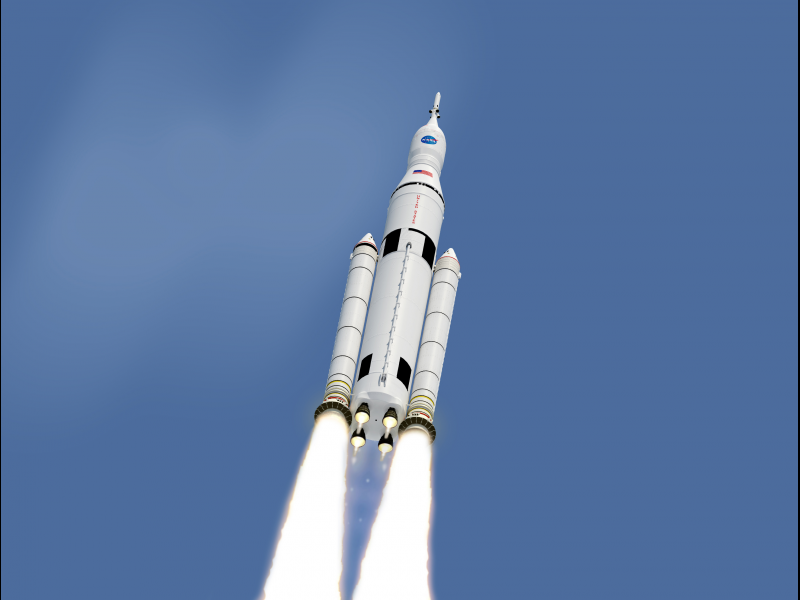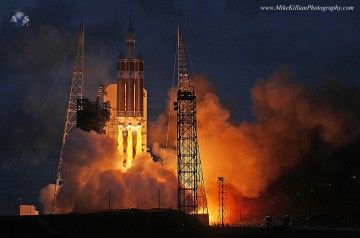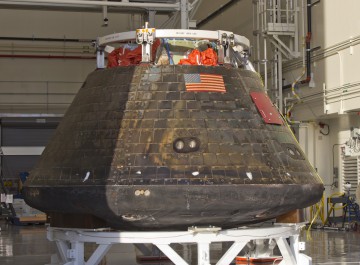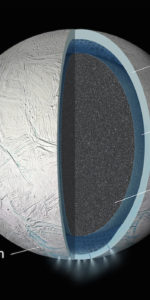
With yesterday’s confirmation of the passage of the critical Key Decision Point (KDP)-C, NASA has taken a significant step within its Orion Program, which will lead to the uncrewed Exploration Mission (EM)-1, no sooner than November 2018—aboard the maiden voyage of the mammoth Space Launch System (SLS) booster—and the piloted EM-2, whose previous No Earlier Than (NET) target of August 2021 has now received an omimous “No Later Than” date of April 2023, in acknowledgement of future budgetary uncertainties. However, with the completion of KDP-C, it was noted that the decision point effectively commits NASA “to a development cost baseline of $6.77 billion” from the beginning of Fiscal Year (FY) 2016 through the completion of the EM-2 flight. “The commitment is consistent with funding levels in the President’s budget request,” the space agency stressed. “Conservative cost and schedule commitments outlined in the KDP-C align the Orion Program with program management best practices that account for potential technical risks and budgetary uncertainty beyond the program’s control.”
As outlined in AmericaSpace’s series of Orion history articles, published last year, the program to develop a new piloted spacecraft to deliver humans Beyond Low-Earth Orbit (BLEO) and eventually outward to Mars has undergone a tortured development process, ever since its conception—during the first administration of President George W. Bush—back in January 2004. Originally known as the Crew Exploration Vehicle (CEV), it was renamed “Orion” in August 2006, but both it and its umbrella “Constellation Program” met with stiff resistance and political opposition and were terminated early in President Barack Obama’s first administration in April 2010. However, development of Orion continued and in May 2011 it was “reborn” as the Multi-Purpose Crew Vehicle (MPCV). Six months later, the Exploration Flight Test (EFT)-1 mission was baselined as a means of demonstrating the spacecraft’s capacity to endure the high radiation environment of the Lower Van Allen Belts and survive a peak re-entry velocity of more than 20,000 mph (32,000 km/h). It was recognized that these blistering speeds, which are far higher than the 17,500 mph (28,800 km/h) experienced during shuttle and Soyuz re-entries, are markedly closer to the velocities that Orion will encounter during a return from lunar distance.
Lofted atop a United Launch Alliance (ULA) Delta IV Heavy from Cape Canaveral Air Force Station, Fla., on 5 December 2014, the EFT-1 mission proved a huge success, delivering an Orion spacecraft to a peak apogee of 3,609 miles (5,808 km), some 15 times higher than the orbit of the International Space Station (ISS), and gave it the farthest vantage point from the Home Planet of a human-capable vehicle since the Apollo 17 lunar landing mission in December 1972. Following a smooth oceanic splashdown and initial transfer to the U.S. Naval Base San Diego, Calif., the EFT-1 spacecraft returned to the Kennedy Space Center (KSC) shortly before Christmas and ushering in a protracted period of disassembly and inspection, prior to its future use in the Ascent Abort-2 (AA-2) test, currently scheduled to occur from the Cape’s Space Launch Complex (SLC)-46 in 2018.

Of course, the EFT-1 spacecraft did not represent a “full-up” Orion spacecraft—equipped as it was with a single-string navigation system, a structural representation of the cylindrical Service Module (SM) attached to its conical Crew Module (CM), a partial Launch Abort System (LAS), and internal batteries, rather than photovoltaic arrays, for electrical power provision—but the post-flight analysis led to a number of significant changes, prior to EM-1. One such change, effected earlier this year, was the decision to implement six “compression pads,” made from an innovative 3-D woven material of quartz fibers, which will be integrated into Orion’s Thermal Protection System (TPS) at the CM/SM interface, alongside the spacecraft’s primary Avcoat ablator.
This work was accompanied by extensive core sampling and laser scanning of EFT-1’s heat shield in the opening months of 2015. In March, the 5,000-pound (2,270-kg) heat shield was delivered to NASA’s Marshall Space Flight Center (MSFC) in Huntsville, Ala., where it was milled and Avcoat sample “squares” were removed from its ablated surface for detailed analysis. Then, in early June, the heat shield was delivered to the Langley Research Center (LaRC) in Hampton, Va., for water impact testing in early 2016 in the Hydro Impact Basin. This is expected to result in full water-landing certification for Orion, prior to the AA-2 test of the Launch Abort System (LAS) in 2018. The latter will see the spacecraft, mounted atop a converted Peacekeeper missile and outfitted with a fully functional LAS, whose trio of solid-fueled motors—abort motor, attitude-control motor, and jettison motor—will demonstrate the capability to pull Orion away from a failed launch vehicle in flight.
Each of these incremental steps have positioned the Orion Program confidently at the KDP-C level, described as “the first time NASA has reached this level of progress for a spacecraft designed to take humans into deep space beyond the Moon, including to an asteroid placed in lunar orbit and on the journey to Mars.” It was stressed that performance data from EFT-1 had assisted with the improvement of manufacturing processes, as the first pair of welds for EM-1 CM were made at the Michoud Assembly Facility (MAF) in New Orleans, La., earlier this month. And in August, the program entered its multi-month-long Critical Design Review (CDR) phase, described as “a rallying point for those with technical stakes in building and flying future Orion missions to ensure all elements are in sync, before moving ahead with full-scale fabrication, assembly, integration and testing.” In parallel, the SLS booster program completed its own CDR in July 2015, positioning it favorably for its maiden voyage with EM-1 in November 2018.

“Every day, teams around the country are moving at full speed to get ready for EM-1, when we’ll flight-test Orion and SLS together in the proving ground of space, far away from the safety of Earth,” said Bill Hill, deputy associate administrator for Exploration Systems Development at the agency’s Washington, D.C., headquarters. “We’re progressing toward eventually sending astronauts deep into space.” Speaking more recently, after the KDP-C decision, NASA Administrator Charlie Bolden added that the effort to send humans into the Solar System was “progressing.” The four-time shuttle astronaut and retired U.S. Marine Corps General pointed out that “Orion is a key piece of the flexible architecture that will enable humanity to set foot on the Red Planet and we are committed to building the spacecraft and other elements necessary to make this a reality.”
Current plans for Orion’s future in terms of actually transporting humans to BLEO destinations remain very much in flux, with the EM-1 voyage and the maiden flight of the SLS not expected until November 2018. This mission will carry an Orion CM—attached to a European Space Agency (ESA)-built SM—on an unpiloted circumlunar flight, although the crewed EM-2 remains unclear. It is currently described as forming part of the Obama Administration’s Asteroid Redirect Mission (ARM), which calls for a pair of U.S. astronauts to rendezvous with and explore a captured asteroid in lunar orbit. However, with considerable criticism having been expressed over the merits of such a venture (as well as an overwhelming “Moon-First” stance of many of NASA’s International Partners), and with a new president due to occupy the White House from January 2017, the future for ARM remains questionable.
Clearly, political machinations and funding issues represent a clear driver for many of the Orion Program’s woes. Yesterday’s announcement of KDP-C was tempered by the inclusion of April 2023 as a “No Later Than” date for the launch of the SLS-boosted EM-2 mission, which will represent a potential 20-month delay for the first piloted voyage of a spacecraft originally proposed almost two decades earlier. Previously targeted for August 2021, EM-2—crewed by two astronauts, on the United States’ first piloted BLEO mission since Apollo 17—is described by NASA as having to potentially move to the right in response to “conservative cost and schedule commitments” that may be “beyond the Program’s control.” Certainly, the ongoing CDR process is expected to include an evaluation of the common aspects of the EM-1 and EM-2 spacecraft, including structures, pyrotechnics, LAS capability, guidance, navigation and control, and software. That said, specific EM-2 systems issues will be addressed at a subsequent CDR in the fall of 2017.
“As we take these steps to develop the capabilities we need to send astronauts deep into space, we’re also aligning how we manage our human exploration systems development programs to ensure we are prepared for unforeseen future hurdles,” said NASA Associate Administrator Robert Lightfoot. “We’re committed to this funding and readiness level to stay on the journey we’ve outlined to get to Mars.” His words were echoed by Associate Administrator for Human Exploration and Operations Bill Gerstenmaier, who pointed out that the agency “will keep working toward an earlier readiness date for a first crewed flight, but will be ready no later than April 2023 and we will keep the spacecraft, rocket and ground systems moving at their own best possible paces.”
Want to keep up-to-date with all things space? Be sure to “Like” AmericaSpace on Facebook and follow us on Twitter: @AmericaSpace
Missions » SLS » EFT-1 » Missions » SLS » EM-1 »





Robert Lightfoot’s comment, “We’re committed to this funding and readiness level to stay on the journey we’ve outlined to get to Mars” sounds like pure political hogwash.
For whatever illogical or highly partisan political ‘reasons’ the President hates the SLS, Orion, and the Moon.
The deep political and scientific reality is, “an overwhelming ‘Moon-First’ stance of many of NASA’s International Partners”, not the confused and zigzagging empty Mars rhetoric of our lame duck President and his hucksters.
The nearby Moon exists and is readily visible to everyone except the visually impaired folks in the White House.
The Moon has extensive resources and opportunities that humans will make use of prior to going to Mars.
Mars is a long ways away, so it makes sense that any mission going there should stay for a while to research – not just a “Yeah! We stepped on the soil and planted a flag, let’s go home” mission. The tech to stay longer on Mars could be developed and proved out at a faster pace on the Moon that’s right in our neighborhood, it only makes sense.
Yep, “The tech to stay longer on Mars could be developed and proved out at a faster pace on the Moon that’s right in our neighborhood, it only makes sense” except to the anti-Moon President, his ‘friend’ the nonscientific Mars huckster, and those highly politicized folks that currently lead NASA and cannot publicly mention the word “Moon” without vague verbal contortions and worrying they might get fired if they don’t repeatedly first ‘sagely’ say “Mars” twenty dozen times.
“Animal Farm” sure was an insightful book!
I wish we would just admit that no Mars manned mission is realistic this side of 2030, and we’ll need a truly global effort to make it happen.
Then maybe if we state it is one of our long term goals, but not an immediate objective we’d stop being distracted over all the stuff that needs to be done first.
That is the problem..Its to close …Not far enough…Not expensive enough…Or maybe Obama gave the moon to Russia and the US took Mars…I think that would be a great example of the Presidents negotiating skills
“Or maybe Obama gave the moon to Russia and the US took Mars…I think that would be a great example of the Presidents negotiating skills” and his clearly demonstrated lack of understanding of the long-term importance of the Moon.
Mars will eventually, in some distant decade, start to have economic and geopolitical importance, but the Moon is our close neighbor and will have significant economic, geopolitical, and strategic importance much sooner.
And despite the President’s clear lack of vision, large arrays of visible light, or radar, telescopes on the Moon will always be potentially dual use and quite capable of scanning the Earth as well as the heavens.
Wouldn’t you love to have the ‘inside track’ to get the contracts to build such arrays? Talk about a long-term moneymaker ‘deal’!
So, you might be wrong Tracy.
In view of our President’s hubris in carefully and consistently obstructing the full implementation of PUBLIC LAW 111–267—OCT. 11, 2010, or otherwise known as the National Aeronautics and Space Administration Authorization Act of 2010, he may well have decided to ‘negotiate’ a ‘deal’ to ‘give’ the Moon to his billionaire ‘friend’, the one that ‘needed’ the incredible advertising advantages and ongoing ‘political influence’ of having exclusive long-term use of America’s critically needed, famous, and massive Launch Pad 39A at the Kennedy Space Center.
Launch Pad 39A is on the National Register of Historic Places and is needed for NASA to launch dual SLS/Orion Lunar missions and for eventually having quick serial SLS launches for Ceres and Mars missions.
It is another “great example of the Presidents negotiating skills” in that the Launch Pad 39A ‘Deal of the Century’ has managed to significantly delay and make it much more expensive and difficult for the American government to do dual Lunar SLS/Orion missions while at the same time he has made it easier, cheaper, and quicker for his ‘anointed Mars poster boy’ to ‘claim’ the nearby and much more lucrative Moon.
What a great ‘public/private deal’ the President appears to be ‘negotiating’ for us as he continues to ignore PUBLIC LAW 111–267—OCT. 11, 2010.
Yep, it might be hard to give “the moon to Russia”.
However, a ‘deal’ with the ‘anointed one’ is a different and easier ‘deal’ to make. Because best of all, lots of naive space cadets will buy the ‘deal’. After all, the Moon is needed for the ‘anointed Martian’ to get ready for Mars missions, right? So ‘obviously’ we should let our favorite ‘Mars huckster’ have both the Moon and Mars.
What a ‘deal’! What a ‘brilliant negotiator’ we have as our President!
Note the comment from Committee Chairman Lamar Smith (R-Texas) in the Press Release From the House Committee on Science, Space, and Technology that was posted Wednesday, September 16, 2015, “Once again, the Obama administration is choosing to delay deep space exploration priorities such as Orion and the Space Launch System that will take U.S. astronauts to the Moon, Mars, and beyond.”
It seems quite likely that no one has clearly explained to Chairman Lamar Smith your idea that “maybe Obama gave the moon to Russia” or my idea that perhaps the President gave both the Moon and Mars to his ‘needy friend’ the ‘Martian billionaire’.
Tracy, I’m not sure I could fully explain all the wonderful business and political ‘perks’ and international ‘benefits’ of either idea to Chairman Lamar Smith, so maybe you should talk to him, OK?
As was noted above by Ben Evans the article’s author, “However, with considerable criticism having been expressed over the merits of such a venture (as well as an overwhelming ‘Moon-First’ stance of many of NASA’s International Partners), and with a new president due to occupy the White House from January 2017, the future for ARM remains questionable.”
Yep, hopefully in “January 2017” we’ll get a NASA headquarters that is orientated towards international space exploration leadership based on the scientific and technological realities noted at NASA’s Lunar CATALYST website by Jason Crusan who is the director of NASA’s Advanced Exploration System division, “Robotic missions to the moon have revealed the existence of local resources including oxygen and water that may be highly valuable for exploration of the solar system. The potential to use the lunar surface in partnership with our international and commercial partners may allow these resources to be characterized and used to enable future exploration and pioneering.”
Alot of these delays are a due to poor thinking in the initial design of Orion and indeed SLS.
For example, Orion was designed by scaling up the Apollo capsule shape – on the basis that this was a conservative, safe idea. Engineers who pointed out that the weight of such a design would become a serious issue were ignored. This in turn fed the crisis with Ares-1 design.
The heat shield had to be AVCOAT monoblock – because a segmented shield was supposed to be too high risk. Due to the weight issue with Orion, the operational, manned version will have a new heat shield. Segmented, and possibly a new material. To be fair, NASA has received some very hard data on the effectiveness of segmented heat shields recently.
Do not get me started on the behavior of ATK regarding the SRBs.
Quite simply, the choice will be between flying manned missions with interim hardware, or waiting and testing the all up versions thoroughly.
I like Orbital ATK. It is a company that can certainly build a lot of different solid rocket motors, or SRMs, and solid rocket boosters, or SRBs.
Two to four SRBs will be used on the new Japanese H3 launcher and two to four SRBs will be used on the new European Ariane 6 launcher.
ULA’s new Vulcan launcher will use one to six SRBs.
Lots of launchers use SRBs, including the SLS.
Orbital ATK is a respectable, trust-worthy, and reliable SRB and SRM company.
And I really don’t think that Orbital ATK would ever try to damage the potential future of the taxpayer funded and legally mandated SLS and Lunar mission Orion by ‘grabbing on to’ and ‘monopolizing’ the critically important Launch Pad 39A that NASA needs to use for efficient dual SLS launched Lunar missions.
American taxpayers paid for the enormous Launch Pad 39A and it is also on the National Register of Historic Places.
Good old Aesop might tell us its kind of a national shame that the enormous and historic Apollo, Skylab, and Space Shuttle Launch Pad 39A has come ‘under the control’ of a ‘Martian billionaire’ to further enrich himself while his political ‘friend’ the President refuses to fully implement PUBLIC LAW 111–267—OCT. 11, 2010, also known as the National Aeronautics and Space Administration Authorization Act of 2010.
And Aesop might note that since the President recently used the word “un-American” to describe folks he disagrees with, perhaps “un-American” could also be used to describe a President who refuses to fully implement a strongly bipartisan law that he himself signed, such as PUBLIC LAW 111–267—OCT. 11, 2010.
Aesop might also consider that word “un-American” could be used to describe a ‘Martian billionaire’ who appears to want to ensure his ‘monopoly’ large launchpad capability and ‘handsome space launch profits’ by ‘helping’ the President in ‘making sure’ that the strongly bipartisan PUBLIC LAW 111–267—OCT. 11, 2010 would be ‘excessively costly’ to fully implement.
Yep, Aesop might carefully ‘explain’ that our ‘anointed Martian billionaire’ could ‘efficiently accomplish’ this ‘nifty’ and ‘lucrative helping task’ by ‘grabbing onto’ and ‘effectively monopolizing’ the famous Launch Pad 39A asset that is needed for NASA’s economical dual SLS launched Lunar missions.
Maybe, if dear old Aesop the Ethiopian slave and fable teller were still living after 2,500 years, he probably could weave quite a morality story about a ‘Martian billionaire’ who is always finding new ways to dig deep into the pockets of American taxpayers and now wants to ‘seize’ a unique and historic piece of public property as an extremely valuable and highly visible advertisement to be used solely by the his ‘anointed business’ for an extended, or maybe even extremely long, period of time.
Perhaps Aesop would explain that ‘obviously’ the ‘king’s’ ‘anointed Martian’ really needs to quickly get ‘super-duper rich’ by ‘any means possible’ in order to ‘legally’, or maybe even ‘not so legally’, ‘grab onto’ and ‘hold’ large and valuable chunks of the Moon and Mars.
Aesop might note how both the ‘Martian billionaire’s’ and ‘king’s’ hubris could be ‘joyously’ pumped up like a balloon and launched to ‘new, exciting, and extremely high orbits’ via outer space ‘politics’ and ‘business deals’.
Maybe Aesop would gently and sadly suggest that perhaps both the ‘king’ and his ‘friend’, the ‘billionaire Martian minion’ don’t want to implement America’s strongly bipartisan PUBLIC LAW 111–267—OCT. 11, 2010 for ‘very clear’ and ‘obvious’ ‘monopolistic reasons’.
And finally, Aesop might also tell us that eventually all the ‘king’s’ national and international good ‘friends’ and ‘not so friendly friends’ decided to form a broad and strong ‘anti-monopoly’ and ‘anti-Martian’ alliance to ‘restrict’ or ‘block’ the ‘anointed one’s’ ‘ill-gotten’ and ‘dangerous’ ‘monopoly huckster profits’ that are ‘intended’ to ‘finance’ his ‘massive land grab’ attempts on both the Moon and Mars.
Yep, where is Aesop when we really need him?
All those technology was done in Apollo Program. NASA has spent billions of US dollars to copy Apollo Command Module but using modern materials. It is good to design new vehicle on the base of accumulated knowledge and experiences. But copying is a job for technicians not for engineers and scientists. What is the next? I do not know. But I know it will be costly, costly and costly and without any vision.